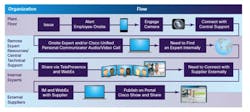In the current ramp-up of manufacturing operations, resources are stretched thin for every type of manufacturer across the supply chain. This means that not every facility will always have a resident expert available to address any one of the myriad problems that can arise on daily basis in a manufacturing operation. But that problem is not as serious as it once would have been.
Addressing this issue with manufacturing in mind, Cisco Systems has been focusing on the use of presence and connection technologies to connect remote subject matter experts (SMEs) along the manufacturing supply chain. According to Kevin Davenport, business development manager, Cisco Systems Inc., remote SME for manufacturing approaches combine “hardened high-definition video, audio streams, and data capabilities to enable remote collaboration. Manufacturers can rapidly find experts, including engineers, technicians, planners and troubleshooters, located anywhere in the world, and deploy them instantly over the virtual platform to address production bottlenecks, train workers, or even help close sales deals.”
The remote SME approach enables a “unified workspace experience for manufacturing workers within the enterprise and outside it that encompasses both their fixed and mobile devices (wired or wireless connections) and can be cloud-based, physical, or virtual in terms of the supporting IT and computing infrastructure,” adds Davenport.
Davenport adds that increasing numbers of manufacturers companies are installing live video and data feeds to monitor operations and control quality throughout the plant and on assembly lines. If trouble signs emerge, remote SME systems let managers “connect with the first engineer or expert available to evaluate and fix the issue,” he says. “These kinds of remote monitoring and diagnostics (RM&D) enable proactive management by-exception by remote experts. Manufacturers can integrate similar RM&D solutions with product deliveries to perform real-time diagnostics at distant customer sites. Companies can record diagnostic sessions, which can be incorporated into online ‘show and share’ portals where engineers and technicians access discussions about root-cause analysis, get training, and share best practices.”
The underlying industrial network platform Cisco relies on to enable its remote SME concept is Industrial IP—unmodified Internet Protocol. Working with ODVA, Panduit and Rockwell Automation, Cisco supports the Industrial IP Advantage (established in 2013). The stated goal of this organization is to help industry deploy a secure, holistic digital communications fabric based on standard, unmodified use of the Internet Protocol.
Referencing a well-known automotive industry manufacturer that asked to have its name withheld for this article, Davenport explains how the company is investigating the use of presence technologies to connect remote SMEs along its supply chain. “This company has been reengineering operations over the past few years to seize growth opportunities in emerging markets and reclaim market share,” he says. “As part of its efforts to reinvent product development and marketing, the automaker has been examining remote expert technologies to quantify potential cost savings, productivity gains, and process cycle time reduction. The company is now looking at several remote visual collaboration solutions to facilitate everything from real-time access to SMEs, plant-floor troubleshooting, and global training of field engineers.”
According to Davenport, this automotive company has identified the following use cases in which remote expert solutions could enhance business performance:
- Improve field service effectiveness and reduce warranty costs—by offering real-time, scheduled, or impromptu access to SMEs via a pervasive video platform;
- Build stronger relationships with external suppliers— by establishing effective B2B video conferencing;
- Get new products to market faster with a faster product launch process—by using video communications to foster dynamic cross-business unit integration; and
- Enable faster and more effective response to plant-floor issues through fast deployment of both internal and external technical support.


